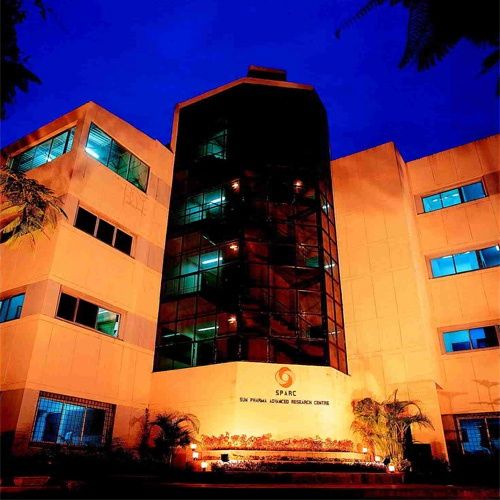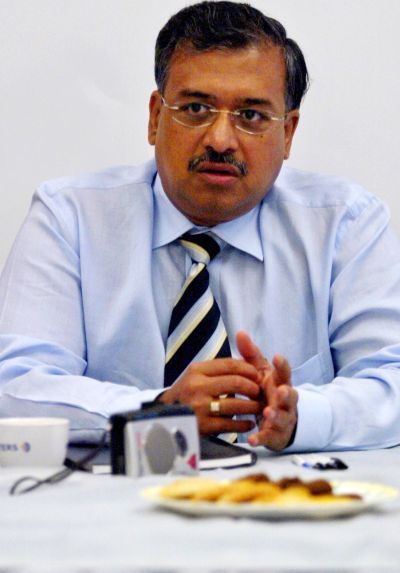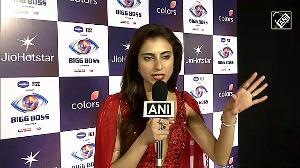Dilip Shanghvi founded Sun Pharma in 1983 with a two-man marketing team and a small manufacturing facility.

The change in India's patents regime in 1970 to process patents gave rise to dozens of drug companies in the country, but few can match the pace of Sun Pharmaceutical Industries.
From a start-up 30 years ago selling niche products, it is now India's largest and most valuable drug maker and set to become the world's fifth largest generic pharmaceuticals company after its acquisition of rival Ranbaxy Labs.
Sun Pharma's rise can only be compared with technology companies, where winners tend to take all. A challenger till a decade ago, Sun Pharma is now more valuable than the combined market capitalisation of its next three competitors in India.

Photograph, courtesy: Sun Pharma
The man behind this success is Dilip S Shanghvi, Sun Pharma's founder and managing director.
Among the most low-profile pharma bosses in India, he founded Sun Pharma in 1983 with a two-man marketing team and a small manufacturing facility to make psychiatry drugs and capsules at Vapi, Gujarat. Since then it has been a story of small victories adding up to a big win.
In the 1980s and 1990s, when his bigger Indian rivals were taking on multinational drug makers in established categories with assistance from India's new patents regime, Shanghvi focused his attention and meagre resources on creating a portfolio of niche generic drugs that were not a priority for others because of their low revenue potential.
Shanghvi was not bothered about the immediate size of the market as his eyes were fixed on the fat margins these least contested categories provided and their long-term potential in a fast-growing economy like India.

Historically, anti-infectives' (drugs used for treatment of infectious diseases) and gastrointestinal therapies have been the biggest revenue drivers for the Indian pharmaceuticals industry.
But these categories are dominated by the Indian arms of multinationals which have been in the market for decades or old Indian drug makers such as Cipla and Ranbaxy. Besides, this market is dispersed nationally and success requires big upfront investment in marketing, sales and distribution.
Rather than fight domestic and foreign incumbents in the then large therapies, Sanghvi focussed on speciality and chronic therapies such as psychiatry, cardiovascular, neurology, oncology and dermatology.
The revenue opportunity was small to begin with, but less competition translated into higher margins that provided Sanghvi the resources to reinvest in the business. Sun Pharma began to attain volume and value leadership in many of these therapies.

As urbanisation grew lifestyle ailments became more prominent, allowing Sun Pharma to grow faster. In contrast, the incidence of infectious diseases declined with improvement in hygiene and standards of living.
Shanghvi was also one the first drug bosses to see through the maze of complexity in India's patent regulations, product approvals, price controls and compulsory licensing.
He chose instead to focus on patients and doctors in the same manner a consumer goods company would do. This meant focusing on brands, pricing strategy, and a sales and distribution network.
This winning formula shows in Sun Pharma's numbers. In the past three years, Sun Pharma has earned an operating profit of Rs 45 for every Rs 100 of revenue.
This is much higher than what peers like GSK Pharma (Rs 34.3), Dr Reddy's Lab (Rs 24.5) and Cipla (Rs 26) earn from their operations.

Sanghvi used Sun Pharma's superior profitability to crank up the growth engine through strategic acquisitions, first in India and then in the US, the world's largest market for generic drugs.
This enabled him to scale up fast and plug gaps in his arsenal: be it products, brands, manufacturing footprint or market reach.
Starting in 1996, when it acquired the bulk drug plant of Knoll Pharma, Sun Pharma completed 17 acquisitions besides a joint venture with MSD, one the world's top pharmaceuticals companies, for product marketing in emerging markets.
And now it is close to acquiring Ranbaxy in the largest drug industry deal in India.
Among his peers, Shanghvi is most open to using mergers and acquisitions (M&A) to grow faster, but he has always been conscious of Sun Pharma's bite size and the price of the acquired asset.

Intangibles such as goodwill and patents that are created while accounting for M&As in the balance sheet, make up for only 36 per cent of Sun Pharma's gross block, against 46 per cent for Dr Reddy's Labs, which has a similar growth strategy.
The financial conservatism is visible in the Ranbaxy acquisition as well. The all-stock deal will double Sun Pharma's revenues at a cost of eight per cent dilution in equity and earning per share. This will be more than taken care off by savings that will accrue by eliminating duplication within the combined entity.
Sanghvi was also quick to understand the business implications of rising life expectancy, especially in North America and Europe, the world's two biggest drug markets. People are not only living longer than their parents but they are also taking more pills for longer, especially for lifestyle ailments.
With the cost of medicines threatening to go through the roof, an increasing number of doctors, patients and governments (where health care is universal and publicly funded) prefer generics over expensive patented drugs.

Sun Pharma logged into this opportunity through a series of strategic acquisitions and investment in branding, marketing and sales, and distribution in all key markets across the globe.
Going forward, the biggest challenge for Sun Pharma will be to protect its newfound leadership without diluting its value and profit leadership in the industry. It will not be easy.
So far in his career, Shanghvi was a challenger trying to make space in an industry dominated by larger and well-established incumbents.
Now Sun Pharma has become an incumbent with about nine per cent market share in India after its merger with Ranbaxy.
Bigger market share has also translated into greater regulatory scrutiny of Sun Pharma's manufacturing and marketing practices. Recently, the company received a warning from the US Food and Drug Administration over its manufacturing practices.
Sun Pharma is also under investigation by the US Congress over allegations of overcharging. The US accounts for nearly three-fourths of Sun Pharma's consolidated revenue.
The immediate task for Shanghvi will be to turn around the operations of Ranbaxy and restore the US regulators' confidence in his processes and products.











